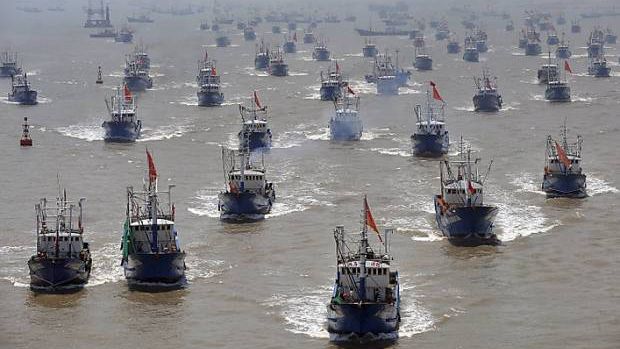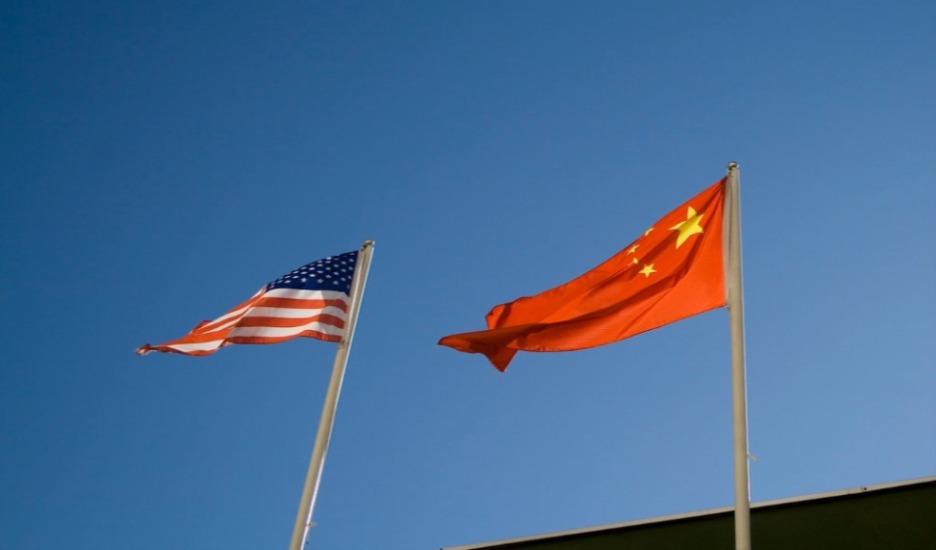Water Wars: Fishermen Again Steer China into Hot Water
Malaysian Officials Fish for a Response to Chinese Trawler Incursion

Chinese fishing vessel fleet (Photo: The Maritime Executive)
Published by The Lawfare Institute
in Cooperation With

Malaysian Officials Fish for a Response to Chinese Trawler Incursion

Chinese fishing vessel fleet (Photo: The Maritime Executive)
Malaysia joined the ranks of countries taking issue with Chinese fishermen last Thursday, as 100 trawlers were detected within Malaysia’s claimed EEZ. On Friday, National Security Minister Shahidan Kassim reported that the Malaysian Maritime Enforcement Agency (MMEA) had sighted foreign vessels within Malaysia’s EEZ and were continuing to monitor the situation. When asked about the incident, PRC Spokesperson Hong Lei said he did not “understand the details” but that “[a]t this time of year, every year, Chinese trawlers are in the relevant waters carrying out normal fishing activities.”
Spokesperson Hong Lei’s confusion was strikingly prescient; two days after Minister Kassim’s initial report, Defense Minister Datuk Seri Hishammuddin Hussein “confirmed that our waters are safe” and denied that any foreign vessels were in Malaysian waters. That same day, however, MMEA Director General Ahmad Puzi Ab Kahar told the press that 82 (not 100) as-yet unidentified foreign vessels remained in Malaysian waters.
Malaysian authorities coalesced around a common narrative another two days later, as MMEA Director General Kahar accused the Chinese Coast Guard of escorting 100 trawlers into Malaysia’s EEZ around Luconia Shoals. More specifically, Director General Kahar said that from Thursday through Sunday MMEA vessels sighted anywhere from 40 to 100 unmarked trawlers accompanied by vessels from the Chinese Coast Guard. National Security Minister Kassim subsequently banned all foreign vessels from fishing in Malaysian waters, and the Foreign Ministry summoned the Chinese Ambassador to communicate its concerns and to “seek clarification.”
In other news...
United States
As President Obama meets with President Xi to discuss South China Sea issues on the sidelines of this week’s nuclear security summit (more coverage on that next week), the Pentagon announced that the United States would not recognize an Air Defense Identification Zone (ADIZ) in the South China Sea. Deputy Secretary of Defense Robert Work said a potential ADIZ would be “destabilizing,” and Pentagon spokesperson Peter Cook called on all countries to pursue diplomatic solutions. PRC Ministry of Defense spokesman Yang Yujun in response asserted that “there is no need for other countries to gesticulate” and that many factors would impact “whether or not or when to set up an air defense identification zone.”
In other news, the USS Boxer left Hong Kong Harbor earlier this week to patrol the South China Sea. Deputy Assistant Secretary of Defense Amy Searight also announced that Tokyo is in talks with Manila to negotiate a status of forces agreement so that “Japan can regularly participate” in U.S.-Philippine joint exercises.
China
PRC officials spent much of the past week refuting criticisms of its presence in the South China Sea. Vice Minister Liu Zhenmin accused “a certain country” (read: the Philippines) of using UNCLOS “as a pretext” to provoke tension and denounced ongoing arbitration at The Hague. Foreign Ministry Spokesperson Hong Lei also defended deployment of HQ-9 and YJ-62 missiles on Woody island as “reasonable and justified,” having “nothing to do with . . . so-called militarization.”
Shifting focus to the United States, an editorial from China Military Online strongly rejected a speech last month from Admiral Swift, accusing Washington of “do[ing] whatever it wants for its own interests.” In response to questions about American FONOPS, Defense Ministry Spokesperson Yang Yujun recommended that “as for the US Ships which came, I can only suggest they be careful.”
Finally, Major General Qian Lihua confirmed that island reclamation would “continue in the future” but claimed that an air defense identification zone had not yet been discussed.
Taiwan
The Taiwanese Coast Guard detained more than 40 people aboard a PRC fishing vessel that was harvesting coral and endangered turtles in protected waters around the Taiwanese-controlled Pratas Islands. The Coast Guard also dispersed eleven PRC fishing vessels and seized another two for investigation. Taiwanese prosecutors are preparing to indict the crew.
Taiwan’s Fisheries Agency released an official report following up on allegations that Indonesian government vessels shot at Taiwanese fishing boats in the Strait of Malacca, after accusations flew last week. Citing information from voyage data recorders, Director General Tsay Tzu-yaw said that the boats were moving too quickly to set fishing nets, as Jakarta has claimed, and reiterated that the boats did not try to ram the Indonesian patrol.
President-Elect Tsai Ying-wen reaffirmed that her party, now in opposition but soon to take power, would never change its stance on Taiwan’s sovereignty claim over Taiping Island despite contrary opinions from some backbenchers.
Japan
On Monday, Japan operationalized a radar station on Yonaguni Island, 90 miles south of the disputed Senkaku/Diaoyu Islands. Ground Self-Defense Force Lieutenant Colonel Daigo Shiomitsu, base commander, said that the listening post would allow Japan to “keep watch on territory surrounding Japan and respond to all situations.” Prof. Toshi Yoshihara of the Naval War College noted that the station will extend a network of overlapping radar sites, “boost[ing] Japan’s ability to monitor the East China Sea.” The expanded base is part of a larger military buildup throughout Japan’s southwestern island chain aimed at deterring Chinese action in the East and South China Seas.
Regional tensions elevated further on Tuesday as Japan’s new security laws took effect. Enacted despite substantial domestic protest last September, the laws allow Japan to aid allies, including the United States, in overseas conflicts. Prime Minister Shinzo Abe, heralding the law, said, “the bond of the [U.S.-Japanese] alliance has been strengthened.” Chief Cabinet Secretary Yoshihide Suga also argued that the laws are essential to protect the Japanese people amidst an “increasingly severe security environment surrounding our country.”
Chinese officials were understandably less effusive. A commentary from Xinhua said that the new security laws shifted Japan “back to a fighting stance for the first time in seven decades” and “exposed” the “warlord prime minister[’s]” goal of “rid[ing] the coattails of Uncle Sam’s ‘pivot to Asia.’” PRC Foreign Ministry Spokesman Hong Lei also denounced Japan’s new security laws and reasserted Chinese sovereignty over the Senkaku/Diaoyu Islands. Additionally, the PRC Defense Ministry suggested that the international community should resist Japanese military expansion.
Indonesia
Indonesian officials appeared divided over a medium-term strategy for responding to last week’s fisheries incident off of Natuna Island. Despite strong statements last week from the Ministry of Fishery and Marine Affairs, for example, Minister of Defense Ryamizard Ryacudu said that “for the time there is no issue” in Sino-Indonesian dialogue concerning the South China Sea. The next day, however, the Commission on Defense and Foreign Affairs of the Indonesian House of Representatives called for a new military base in the Natuna Islands to strengthen “the defense system in the central region of Indonesia.” Nevertheless, Chinese vessels left port the following day to join a blue-water training run by the Indonesian Navy. Prashanth Parameswaran at The Diplomat takes a deeper look at Indonesia’s evolving response.
Philippines
Military procurement was the name of the game this week for the Philippines. IHS Jane’s reports that three former Royal Australian Navy Balikpapan-class landing craft purchased by the Philippines in October 2015 have been received but are waiting for general servicing before deployment. Two days later, President Benigno Aquino III told reporters that the Philippines might also purchase its first submarine as the country “accelerate[s] the modernization of our armed forces.” He stressed, however, that Manila is not “trying to engage anybody in an arms race, or in a military build-up.”
Vietnam
Vietnam also turned its eye towards military modernization this week. Kommersant, an independent Russian newspaper, reported that Hanoi is looking to purchase up to twelve Su-35 fighters to augment its existing Su-30MK2 fleet. Vietnam is also partnering with India to build a jointly operated satellite data transmission station. The Asahi Shimbun reports that officials in the Vietnamese Ministry of Defense are using the station as part of a larger plan to “strengthen intelligence-gathering capabilities in the South China Sea.”
Notwithstanding this buildup, Minister of National Defense General Phung Quang Thanh welcomed his PRC counterpart to the third Vietnam-China Border Defense Friendship Exchange. Usual pleasantries were exchanged, and Vietnamese Communist Party General Secretary Nguyen Phu Trong called on the two countries to continue high-level meetings, carry out joint patrols, and promote closer mil-mil coordination.
Singapore
Defense Minister Ng Eng Hen expressed concern about growing South China Sea militarization, worrying that Asia “doesn’t have an equivalent of never again should a conflagration arise in Asia” and therefore is more at risk of unintended conflict. He called for increased mil-mil cooperation to prevent miscalculation and projected that Singaporean defense spending would remain at 3 to 3.3% of GDP. Minister Ng also conceded that China’s “position as a leader will have to be recognized and that there will be new rules, but China has to decide what these new rules are.”
Analysis, Commentary, and Additional Information
A number of analysts this week ruminated on the strategic and political ramifications of increasing militarization in the South China Sea. Timothy Heath opined that the PRC’s HQ-9 deployment, while of limited impact militarily, signals the extent to which China is willing to bypass American criticism. Koh Swee Lean Collin explores China’s “White Hull” strategy, and Steven Stashwick looks at how China’s high-frequency radar station on Cuarteron Reef could be used to extend the Coast Guard’s reach. AMTI provides a great overview of recent, but less-noted, Chinese military buildups and how they extend detection and defense capabilities in the South China Sea.Looking forward, Robert Klipper outlines why China might occupy and build on Scarborough Shoal.
In a widely shared piece, our new Contributing Editor, Julian Ku, considers whether China’s nine-dash-line should be understood as a “super-sized exclusive economic zone.” And finally, for our 中国通 (Chinese readers), Liu Haiyang presents a Chinese perspective on how the U.S. is winning the public-relations war in the South China Sea.
Water Wars is our weekly roundup of the latest news, analysis, and opinions related to ongoing tensions in the South and East China Seas. Please feel free to email Chris Mirasola with breaking news or relevant documents.


.jpg?sfvrsn=5a43131e_9)


